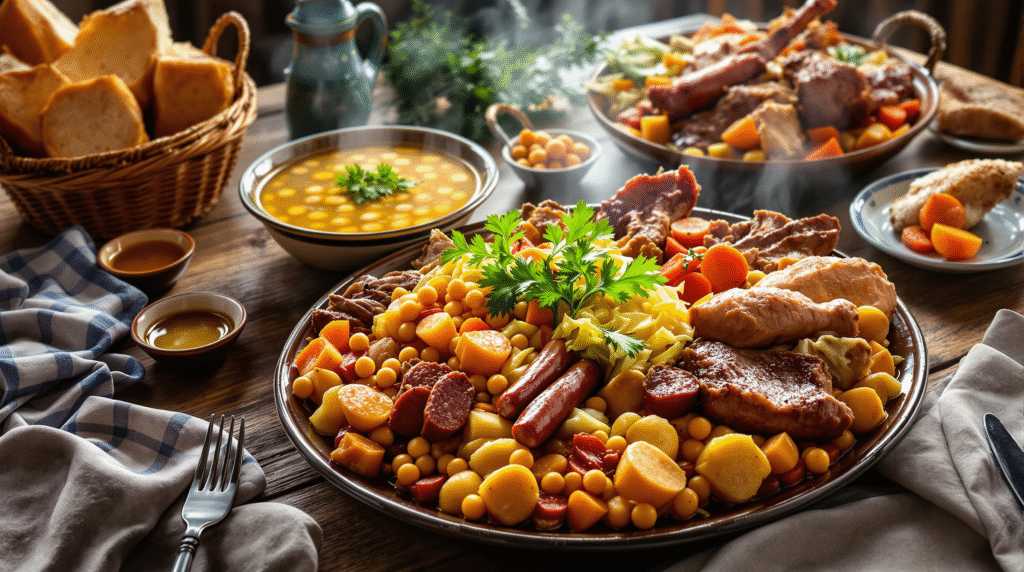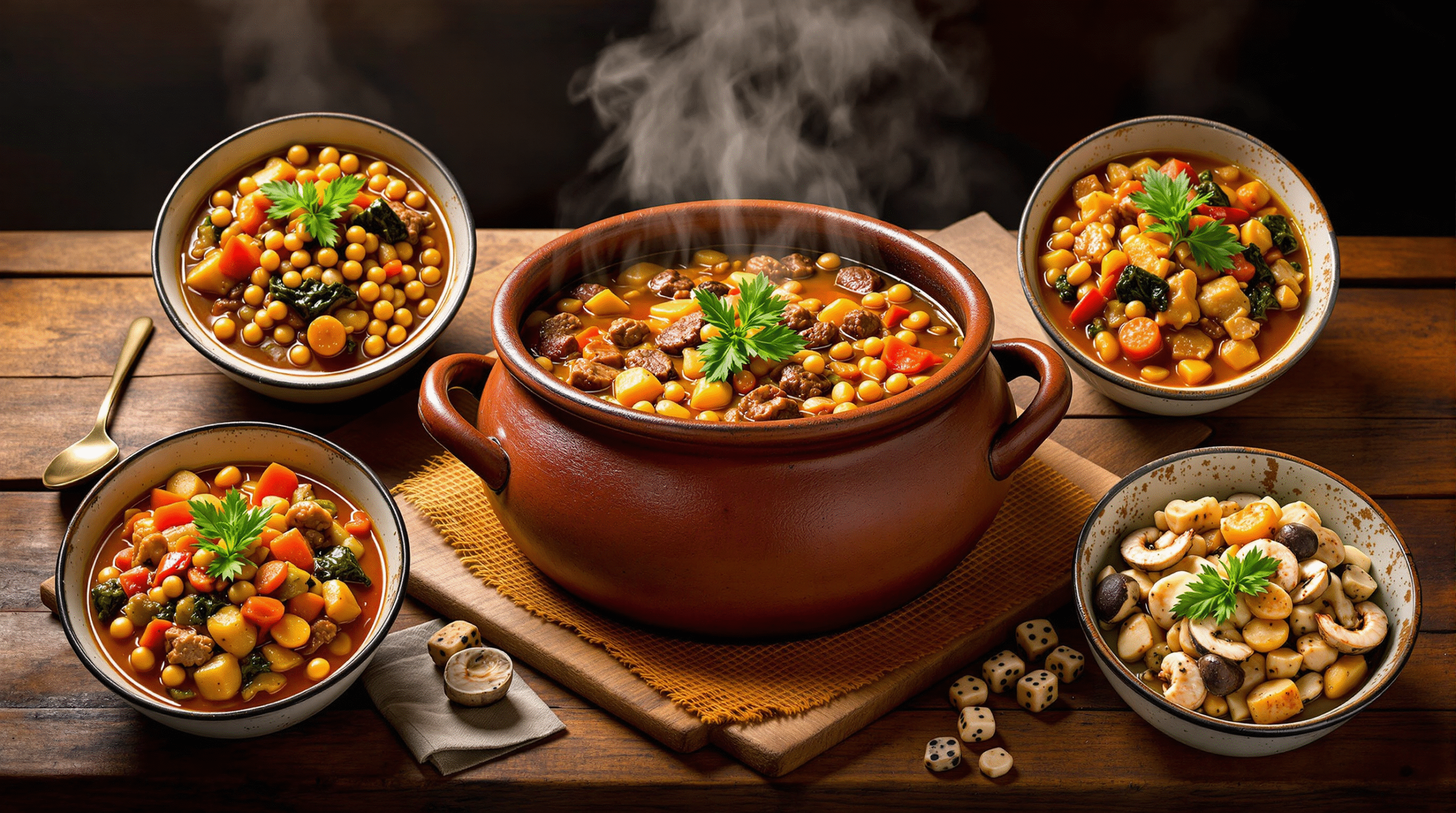Have you ever wondered why some traditional dishes survive for centuries while others fade away? The secret might just lie in their ability to adapt while maintaining their soul. Cocido Madrileño, Madrid’s iconic stew, is the perfect example of culinary resilience through variation!
Overview: Madrid’s Heartwarming Stew
Cocido Madrileño isn’t just food—it’s a celebration in a pot! This hearty Spanish stew combines meats, vegetables, and chickpeas in a flavorful broth that warms both body and spirit.
Time requirement: 2-3 hours (mostly hands-off simmering) Difficulty level: Moderate (simple techniques but requires patience) Why it’s special: Cocido Madrileño represents Spanish comfort food at its finest. The dish follows the traditional “three-course” serving style where the broth, vegetables, and meats are enjoyed separately, creating a complete meal experience.

Essential Ingredients
The Foundation
- Chickpeas (garbanzos): The star legume that gives Cocido its distinctive character. Soak them overnight for best results.
- Meats: Typically includes beef shank, pork belly, chicken, and Spanish chorizo.
- Vegetables: Carrots, potatoes, cabbage, and turnips form the veggie base.
- Morcilla: Spanish blood sausage adds richness (optional but traditional).
- Bone marrow: For extra flavor depth.
- Aromatics: Onion, garlic, bay leaves, and saffron.
Substitutions
- No chickpeas? White beans work in a pinch.
- Chorizo unavailable? Use smoked paprika and another sausage.
- Vegetarian? Skip the meats and double up on vegetables and chickpeas.
- No morcilla? It’s okay to leave it out.
Step-by-Step Instructions
Preparation (Day Before)
- Place 1 pound of dried chickpeas in a large bowl.
- Cover with cold water (at least 2 inches above the chickpeas).
- Add 1 tablespoon of salt and stir.
- Let soak overnight or at least 8 hours.
Cooking Day
- Prepare the broth:
- Fill a large pot with 3 quarts of water.
- Add 1 whole peeled onion studded with 2 cloves.
- Add 2 bay leaves and a pinch of saffron.
- Bring to a boil.
- Add the meats:
- Add 1 pound beef shank, 1/2 pound pork belly, and 1 chicken quarter.
- Return to a boil, then reduce to a simmer.
- Skim off any foam that rises to the surface.
- Simmer for 1 hour.
- Add the chickpeas and vegetables:
- Drain and rinse the soaked chickpeas.
- Add chickpeas to the pot.
- Add 2 carrots (peeled and chunked), 1 turnip (peeled and quartered), and 1/2 cabbage (cut into wedges).
- Simmer for another hour.
- Final additions:
- Add 4 peeled and quartered potatoes.
- Add 4 ounces chorizo and 4 ounces morcilla (if using).
- Simmer for 30 minutes more, until potatoes are tender.
Cooking Tips
- Keep the simmer gentle—never let it boil rapidly.
- Cook in a clay pot if possible for authentic flavor.
- The broth should be clear, not cloudy—skim regularly.
- Test chickpeas for doneness—they should be creamy inside but hold their shape.
Assembly: The Three-Course Tradition
Cocido Madrileño is traditionally served in three separate courses:
- First course (Sopa): Strain some broth and serve with thin noodles or rice.
- Second course (Garbanzos y Verduras): Serve the chickpeas and vegetables together.
- Third course (Carnes): Present the meats sliced on a platter.
Presentation Tips
- Use wide, shallow bowls for the soup course.
- Arrange vegetables and chickpeas in colorful patterns.
- Slice meats thinly across the grain for tenderness.
- Garnish with fresh parsley for color.
- Serve with crusty bread and a simple green salad.
Storage and Make-Ahead Tips
Cocido Madrileño actually improves with time! Here’s how to make the most of it:
- Make ahead: Prepare the entire dish 1-2 days before serving. The flavors will deepen.
- Refrigeration: Store components separately in airtight containers for up to 4 days.
- Freezing: The broth and meats freeze well for up to 3 months. Chickpeas and vegetables are best eaten fresh.
- Reheating: Warm the broth first, then add components gradually to avoid overcooking.
- Leftovers: Use leftover meats in sandwiches, chickpeas in salads, and vegetables in omelets.
5 Delicious Variations You Need to Try
1. Cocido Madrileño Ligero (Lighter Version)
Perfect for warmer months or those watching calories.
- Use chicken and turkey instead of red meats.
- Double the vegetables.
- Skip the morcilla and reduce chorizo.
- Add fresh herbs like thyme and rosemary.
- Serve with a squeeze of lemon for brightness.
2. Cocido Montañés (Mountain Style)
A northern Spanish variation with a rustic twist.
- Replace chickpeas with white beans.
- Add collard greens or kale.
- Include more pork products (ribs, ear, trotters).
- Add smoked paprika for depth.
- Serve with cornbread instead of wheat bread.
3. Cocido with Seafood Twist
A coastal-inspired variation.
- Add firm white fish pieces in the last 10 minutes.
- Include a few shrimp or mussels.
- Use fish stock for part of the broth.
- Add a pinch of saffron and a splash of white wine.
- Garnish with fresh dill and lemon zest.
4. Vegetarian Cocido
A plant-based version that doesn’t sacrifice flavor.
- Replace meats with mushrooms (portobello and shiitake).
- Add smoked paprika and liquid smoke for depth.
- Include extra-firm tofu chunks.
- Double the chickpeas and add other beans for protein.
- Use vegetable broth enhanced with nutritional yeast.
5. Pressure Cooker Express Cocido
For busy weeknights when you crave comfort food.
- Use canned chickpeas (drained and rinsed).
- Cut meat into smaller pieces.
- Layer ingredients carefully (meats first, vegetables on top).
- Cook under pressure for 30 minutes.
- Quick-release and add pre-boiled potatoes at the end.
Conclusion
Cocido Madrileño isn’t just a recipe—it’s a celebration of Spanish culinary tradition that welcomes adaptation. Whether you stick to the classic version or try one of our variations, you’re participating in a centuries-old tradition of gathering around a steaming pot of goodness.
Don’t be afraid to create your own variation based on what’s available in your region or what your family enjoys. The beauty of Cocido lies in its flexibility while maintaining its comforting essence.
So gather your ingredients, set aside a leisurely afternoon, and prepare to fill your home with the irresistible aromas of this Spanish classic. Your taste buds—and anyone lucky enough to join you at the table—will thank you!
FAQs About Cocido Madrileño
Is Cocido Madrileño healthy?
Yes! It contains a balanced mix of proteins, complex carbohydrates, and vegetables. The broth is nutrient-rich, and chickpeas provide fiber and plant protein. For a healthier version, skim excess fat from the broth and increase the vegetables.
Can I make Cocido Madrileño in a slow cooker?
Absolutely! Cook on low for 8-10 hours. Add the potatoes and sausages in the last 2 hours to prevent overcooking.
What wines pair well with Cocido?
A medium-bodied Spanish red like Tempranillo or Garnacha complements the rich flavors perfectly. For white wine lovers, try a full-bodied Albariño.
Can I prepare components separately?
Yes! You can cook the chickpeas separately if you prefer, though they won’t absorb as much flavor. The meats can also be browned first for extra depth.
Is this dish suitable for special diets?
The traditional recipe isn’t gluten-free, dairy-free, or vegetarian, but our variations include options for different dietary needs. The vegetarian version is particularly adaptable for vegan diets by omitting any animal products.
How do I know when the chickpeas are perfectly cooked?
They should be creamy inside but still hold their shape. If they’re falling apart, they’re overcooked. If they have any crunch, they need more time.

